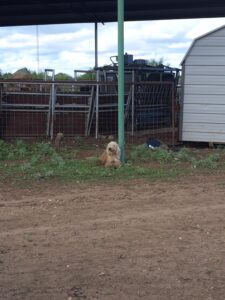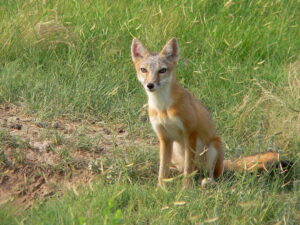 The summer heat and some moisture across the state have increased the number of flies in many locations. It is important to watch your LGDs for signs of a fly strike. We see it very often in short-haired LGD breeds, but it can also occur in long-haired LGDs. We use three products on our dogs that are susceptible to fly strikes. All three products from Farnam are commonly found in feed and farm stores. We use Swat ointment and a long-acting fly spray as preventative measures for dogs. If a dog has fly strike, we like to use Tri-Care ointment. Tri-Care ointment has a fly repellent, prevents infections, and relieves pain. Tri-Care is an excellent product for all minor wounds on dogs and livestock.
The summer heat and some moisture across the state have increased the number of flies in many locations. It is important to watch your LGDs for signs of a fly strike. We see it very often in short-haired LGD breeds, but it can also occur in long-haired LGDs. We use three products on our dogs that are susceptible to fly strikes. All three products from Farnam are commonly found in feed and farm stores. We use Swat ointment and a long-acting fly spray as preventative measures for dogs. If a dog has fly strike, we like to use Tri-Care ointment. Tri-Care ointment has a fly repellent, prevents infections, and relieves pain. Tri-Care is an excellent product for all minor wounds on dogs and livestock.
AgriLife Livestock Guardian Dog Program: Update and Events
Please mark your calendars for our next online seminar on Sept.19 at 3 p.m. CST. We are thrilled to have Dr. Julie Young from Utah State University, a renowned researcher in LGDs, share her extensive knowledge, research, and insights. This enlightening event is an excellent opportunity for all LGD enthusiasts. To secure your spot, watch the events page on our website. The workshop will be hosted on Zoom, ensuring easy access for all, and as always, it is free!
Get ready for the 51st Annual AgriLife Center Field Day, a day filled with informative sessions and engaging activities, to be held on Aug.16 from 8 a.m. – noonat the AgriLife Center in San Angelo. This will be followed by the highly anticipated Texas Sheep and Goat Expo at the Spur Arena on Aug. 16 – 17. As part of the Expo, we are hosting an LGD workshop on Aug. 16, a fantastic opportunity for producers to enhance their knowledge and skills in LGDs. Producers can register for the field day and Expo on the AgriLife Center – San Angelo’s events page. And do not forget that the Texas LGD Association will hold its annual in-person meeting immediately after the Expo ends on Aug.17 in the lobby of the Spur Arena.
from 8 a.m. – noonat the AgriLife Center in San Angelo. This will be followed by the highly anticipated Texas Sheep and Goat Expo at the Spur Arena on Aug. 16 – 17. As part of the Expo, we are hosting an LGD workshop on Aug. 16, a fantastic opportunity for producers to enhance their knowledge and skills in LGDs. Producers can register for the field day and Expo on the AgriLife Center – San Angelo’s events page. And do not forget that the Texas LGD Association will hold its annual in-person meeting immediately after the Expo ends on Aug.17 in the lobby of the Spur Arena.
If you are looking for information on LGDs, make sure to check out our website. It contains factsheets, research from around the world on LGDs, and case studies we have conducted.
Adding New LGDs to Your Pack
We frequently get questions about adding a new LGD to your current pack or group of dogs. This can be incredibly stressful and dangerous for the new dog. We recommend starting with a younger dog that has not reached adolescence, as they are more likely to be submissive to the established dog or pack and accepted by them without injury. Older mature dogs are more likely to fight as they have already established dominance in their previous setting. This situation can lead to injuries or death for new and established dogs on the ranch. It is vital to introduce new dogs slowly in a controlled setting.
Introducing a new dog should be a gradual and carefully managed process. We recommend that you follow these steps whether you have a young dog or an older dog you are trying to add. First, introduce them across the fence line with the new dog leashed for 15-20 minutes four to five times weekly. Then, place the new dog and the most dominant dog or dogs in the group into a secure pen. Have the current dogs tethered before bringing the new dog into the pen on a leash. This is especially important as it allows you to pull the dogs apart should they start to fight. Allow the dogs to socialize with each other for at least 15-20 minutes. Do this at least four to five times for the second week. Make sure to interact with all the dogs so that the current dogs learn that it is okay for the new dog to be there. Plenty of treats are helpful to have on hand during this entire process to reward good behavior. Always try to end the sessions on a positive note. Shorter, more frequent sessions are preferred over longer, less frequent ones.
Observing the dogs’ behavior and understanding their interactions is crucial as you progress through the weeks. This will help you identify any potential issues and address them early on. Excessive aggression at the stages or constant straying by a specific dog may mean one dog is being bullied, and joining these dogs may need to be abandoned. In the third week, allow the new dog into the pen without a leash with the same adult dominant dog or dogs tethered. Repeat this for 10-15 minutes for four to five days. During the fourth week, allow the tethered dog or dogs to be on a leash while the new dog is free. If you have multiple dogs, having another person there will be beneficial if a fight arises. In the fifth week, introduce feed in bowls to each dog in the group pen area. This is generally when aggression may occur if the dog has resource-guarding tendencies. You may need to work with one or more dogs for a week to get past this issue. It is sometimes difficult to overcome resource guarding in older dogs, and it may be easier to add another feeding station 50-60 feet away from the original feeding station so that the new dog can eat.

Pearl during tether testing. She did an excellent job and received a perfect score. AgriLife picture courtesy Costanzo 2024.
Bonding Project Update
Round Five Dogs
Six of the seven dogs graduated from round five of the bonding project. Mabel is the last dog that needs to be evaluated in August. The producer was on vacation for a couple of weeks in July, which postponed her final test until he returned. Since starting the project last fall, all producers are happy with their dogs and have seen a decrease in predation or no predation on their livestock. We will update you on Mabel and the other pups here and on our Facebook page.
Round Six Dogs
So far, the pups in round six are all doing well in their training pastures. The “Santa’s Reindeer” pups all wear Invisible Fence Brand collars to ensure they respect fence boundaries. The “L Girls” are wearing a new collar from SpotOn Fence that we are evaluating. The pups are frequently seen with their charges, which is a good sign that the bonding process went well.
Santa Reindeer pups still receive three days of socialization a week, as we often change the batteries in

Santa’s Reindeer pups resting in the shade with their charges. AgriLife picture courtesy Costanzo 2024.
their collars. The “L Girls” continue to get one day a week of socialization as the batteries in the SpotOn Fence collar are long-lasting. Moving forward, all pups will continue to receive hot wire training and some invisible fence collar training. The first five rounds of the bonding project have shown that pups bonded and raised in pens with hot wire roam or patrol outside pasture boundaries drastically less than pups bonded without hot wire in the pens. These pups will be looking for ranches to work on in late October or early November of this year. Please contact me at bill.costanzo@ag.tamu.edu if you are interested in participating in this round of the bonding project.
Round Seven
In 2025, round seven of the bonding project will incorporate cattle. In round seven, we will bond four dogs in hot wire to cattle as part of a project to help restore Swift foxes in the Rita Blanca National Grasslands. We will look for pups 8 weeks old in late January and early February 2025. Please contact us if you plan to have a litter during that time. We are looking for breeds we have not tried to bond in previous years. Future rounds of the bonding project will include training for aerial threats, tethering, acclimation to deer/exotics, and training dogs to combat feral hogs.
In closing
If you enjoyed this monthly LGD blog, please remember to subscribe to it with this link: The Guardian Way | Texas A&M AgriLife Research and Extension Center at San Angelo.
If you have feedback on this article or would like to suggest topics for future articles, webinars, or workshops, please contact me at bill.costanzo@ag.tamu.edu or 325-657-7311. The Texas A&M AgriLife Livestock Guardian Dog Program is a cooperative effort by Texas A&M AgriLife and the Texas Sheep and Goat Predator Management Board. Follow us on our social media sites and share them with your friends and family!
Facebook, Instagram, YouTube: @TAMUlivestockguarddog
 Remember to check out the Texas LGD Association online! You can follow the organization on Facebook or YouTube at @TexasLGDAssociation or visit its website.
Remember to check out the Texas LGD Association online! You can follow the organization on Facebook or YouTube at @TexasLGDAssociation or visit its website.





